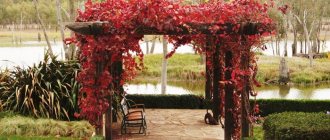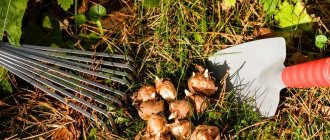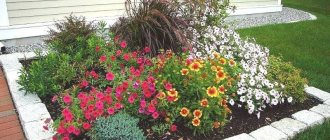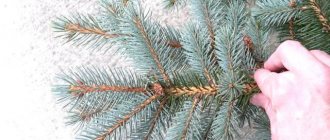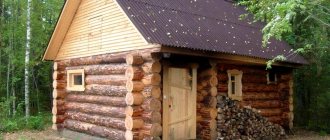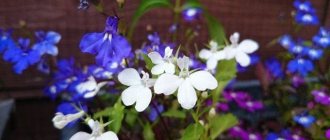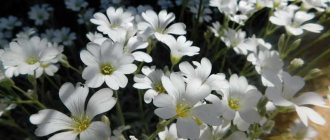Lobelia is a sought-after flower, available in numerous varieties. You can choose both annuals and perennials. The flower is represented not only by herbaceous plants, but also by shrubs and subshrubs.
Lobelia
Important! Due to the unpretentiousness of lobelia, it is grown in different countries, but the subtropics are considered the best climate for its effective growth and flowering.
Description of Lobelia
There are more than 300 different types of lobelia, and some are used to create various medicines intended to treat lung diseases.
Cultivated plants are presented in 20 species; caring for all varieties is considered a simple job, accessible even to a novice gardener. There is no need to pay too much attention to this process, and lobelias can be planted with seeds or seedlings.
In the Russian climate, lobelia is grown as an annual plant. It is represented by a small bush, the height of which does not exceed 20 cm, although the height of some unique varieties can reach 1.5 m. In appearance, the bush resembles a ball. The stems are thin and branching from the base of the plant. They grow more lanceolate leaves. The flowers are axillary and bilabial, usually 2 cm in diameter. Their colors may vary depending on the variety, but the most common are white, blue, violet or purple flowers.
Important! Lobelia flowering begins in mid-June and lasts until the beginning of autumn, and at the end of flowering, significant sized fruits remain, represented by multi-seeded capsules, and the seeds in them can be effectively used for planting for three years.
Application options in landscape design
Culture is characterized by amazing plasticity. It can be used beautifully on the lawn, can be used as a small-colored carpet under large garden plantings, and looks good in decorative compositions.
Interesting landscape compositions with lobelia :
- imitation spring. Varieties with blue inflorescences easily imitate water that gushes from a spring and flows out in cheerful waves;
- waterfall. A vertical flower bed with tiers of flowers in blue and light blue with white spots creates an imitation of a cascading waterfall;
- with a fallen jug. Plant varieties with pale blue inflorescences to imitate water flowing from an inverted vessel. It is better to choose a source jug with a wide neck; a broken one, with cracks and chips, is also suitable;
- in the basket. Ampelous types of lobelia in decorative containers, including a basket, a pot in the shape of a saucepan, a teapot or a pot-bellied vase, look impressive on the terrace and balcony, and can decorate a summer kitchen and gazebo;
- tower. You can choose a flowerpot with special holes on the surface for planting miniature annuals. A tower structure can also be easily built using 2-3 clay pots arranged in a pyramid. Place a flower tower near your gate or on your porch steps.
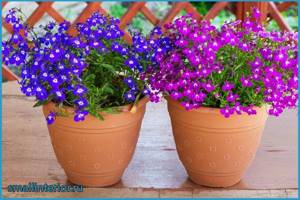
In which even an inexperienced gardener can plant and care
Varieties Pumila (dwarf varieties with abundant, long-lasting flowering) and Compacta (mini varieties with relatively large flowers) are considered ideal as border plants. Bushes planted along the perimeter of the flower garden form a dense strip of multi-colored hemispheres.

Compact versions are also advantageous to use on alpine slides; they are also good in rock gardens. Unlike their hanging relatives, bush varieties form a crown with clearly defined shapes, resembling a pillow, boulder, ball or hemisphere. For this reason, they fit harmoniously into the design of a rocky garden, a dry stream, or a rock garden.
Types and varieties of lobelia
Lobelia can be an annual or perennial plant. The most popular are annuals represented by the following species:
- Erinus. Otherwise called border lobelia, blue or hedgehog. The flower is presented in five different forms, so you can choose a climbing or dwarf plant, spreading or compact, as well as erect. A popular variety of this type is Regatta Rose, which has a bright pink color. Another variety is called Riviera Sky Blue, which has an unusual sky blue color, so it decorates any area.
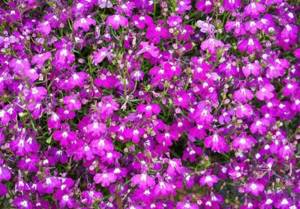
Lobelia Regatta Rose

Lobelia Riviera Sky Blue
- Strong. This type of lobelia is similar to the previous variety, but the stems have significant power and the leaves are juicy. The flowers are large in size and may have a blue or purple tint. In the center of such flowers there is a unique white spot.

Lobelia valida
- The finest lobelia. Its height can be 35 cm, and the flowers are 2 cm in diameter. They have a blue, lilac or white tint. It is grown as an annual or perennial plant.
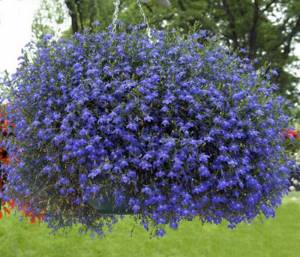
Lobelia tenuior
Among the perennials, the following types of lobelia stand out:
- Brilliant. The average height is 75 cm, and the leaves can be red or green. The Queen Victoria variety of this species is considered the most popular, and its height can be one and a half meters. The plant has large scarlet flowers that attract attention in any area.
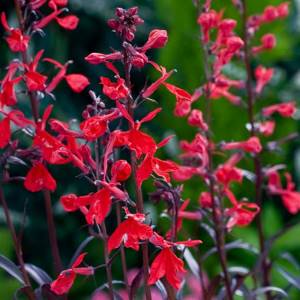
Lobelia Queen Victoria
- Dortman. This type of lobelia is considered endangered and is therefore listed in the Red Book. It grows exclusively on sandy bottoms in coastal areas. For its growth, it is important that the sand is perfectly clean, and the optimal growth depth is 70 cm.

Lobelia dortmanna
- Gherardi. A frost-resistant type of lobelia that can easily cope with temperatures of -29 degrees. Its height is 1.25 cm, and all the flowers are collected in spike-shaped inflorescences. Vedrariensis is considered the most popular variety of this species.

Lobelia Vedrariensis
- Purple. Another name for the species is cardinal. Its height usually reaches one meter. The flower got its name due to its bright purple color.
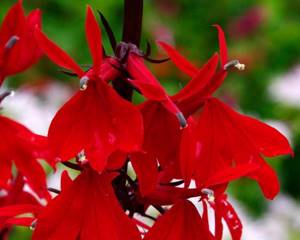
Lobelia cardinalis (Lobelia cardinalis)
- Blue. This species was brought from America. It is equipped with blue-violet flowers, collected in large and dense spike-shaped inflorescences.

Lobelia blue
Thus, when choosing lobelia, you should decide on the type and variety.
Important! Initially, you need to decide whether annuals or perennials will be grown on the site, since the latter require care in autumn, winter and spring.
Growing lobelia from seeds
Lobelia is grown by seeds, and it is recommended to initially obtain seedlings at home, after which they are planted in open ground. This is due to the fact that if in the regions at the end of spring the temperature is not too warm and frosts are observed, then it is advisable to plant seedlings in mid-June.
The entire process of obtaining seedlings consists of the following stages:
- special cassettes are prepared for lobelia seedlings;
- A drainage layer is laid in them at the beginning of February, for which expanded clay or crushed bark is used;
- soil is poured on top, and it is desirable that it be light and well kneaded, and it is also recommended to first mix it with coconut fibers or clean sand;
- the laid soil is well watered so that it is eventually saturated with moisture;
- sowing begins only after the soil settles;
- lobelia seeds must first be mixed with a small amount of sand, and the seeds should not be planted deep into the ground, as this may become an obstacle to their ascent;
- the seeds are sprinkled with clean river sand on top, which will reduce the rate of absorption and evaporation of water from the soil;
- the cassette is covered with film or glass, after which it is installed in a place where it will receive a lot of sunlight.
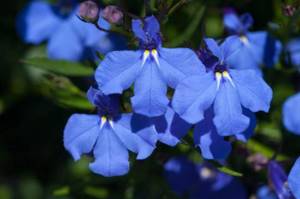
Important! To obtain high-quality and strong lobelia seedlings, you should not allow excessively dry air in the room where the cassettes are located, and you should not allow the soil to dry out, as this will lead to thinning of the sprouts, so they may die.
Excessive moisture will not damage the lobelia, so it is necessary to water the seedlings regularly. It is not allowed to leave small sprouts without film, and this is especially true if the cassettes are installed in a room where the temperature is 22 degrees or higher.
Watering lobelia is done in the tray of the cassette, and not on the sprouts themselves, since improper watering can lead to the seedlings being flooded.
For about the first 30 days after planting, there will be practically no visible seedlings at all, since they grow extremely slowly. But then the growth will accelerate significantly, and as soon as the seedlings reach a height of 4 cm, then picking is performed, for which approximately 3 sprouts are planted in disposable cups. When the seedlings are 7 cm in height, you need to pinch the plants, which stimulates their branching.
Important! Lobelia begins to bloom at home, when it is represented by seedlings.
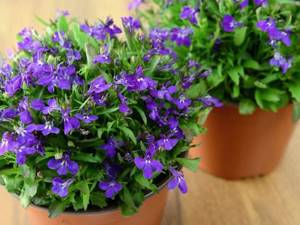
How to grow lobelia correctly (video)
After sowing, there is no need to sprinkle the seeds with substrate. It is better to simply spray the surface with a weak solution of potassium permanganate (potassium permanganate) through the finest spray bottle. Then the container needs to be covered with glass, creating a kind of greenhouse for the seeds. The glass must be removed and wiped every day to avoid “steaming” the seeds. Otherwise, they will not germinate, but will simply rot.
If high-quality seed material is purchased, the first shoots will appear within 10 - 15 days after sowing.
The sprouted plants should be left in the greenhouse, but not under glass, but under a plastic bag so that there is more air under it. In order for small plants to grow faster, you need to place the greenhouse in the brightest place and often open the bag for ventilation.
There is no need to water the seedlings - it is better to moisten the substrate by adding a little water to a tray placed under the container with the young shoots.
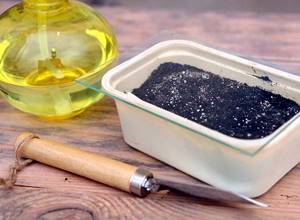
Planting lobelia
Prepared seedlings are planted in the ground at the end of May or early June. It is necessary to make sure that night frosts have completely stopped, as they can lead to the death of plants. To get an ideal result, you need to take into account some features and rules for planting lobelia:
- a sunny area on the territory is selected for planting so that a lot of sunlight falls on the seedlings;
- the soil for lobelia is chosen to be loose, but it should not be extremely fertile, so sandy loam soil or loam is considered the best choice;
- when preparing the soil, it is allowed to add fertilizers to the soil, but you cannot overdo it with nitrogen, since it contributes to the intensive development of lobelia leaves, but there will be no flowering;
- for seedlings, holes of optimal size are prepared, and the distance between them should be within 12 cm;
- Planting into holes is carried out by transshipment.
Some exquisite varieties of lobelia are recommended to be planted not in open ground, but in pots or baskets, and installed on balconies or verandas. These flowers are often used in the design of alpine slides and rockeries.
If perennials are grown on the territory, then in the fall they can be dug up, after which they are transplanted into cold greenhouses. In this case, they will be reliably protected from frost, so in spring they can again be planted in the open area.
If the flowers are really beautiful, then they can be left at home for winter storage, and in the spring the lobelia bushes are divided into cuttings, after which they are planted in various suitable containers.
Planting is carried out only after the plants have taken root, and this vegetative method is used only if there are concerns that the varietal characteristics of lobelia will not be preserved by seed propagation.
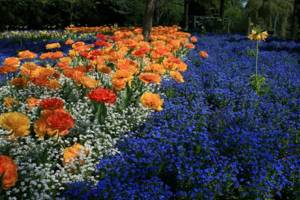
Frost resistance
The White Lady, in the Russian climate, is an annual plant and blooms in September; it does not overwinter in open ground. Unless we are talking about taking a cutting from a plant. In this case, the bush is planted in a pot and taken to a warm room.
Lobelia variety White Lady looks very good as a border along the path. Along the edge of a flower bed or pond. Looks impressive in hanging baskets and carpet planting. This variety is popular among gardeners for its charming snow-white flowers and ease of care.
If you find an error, please select a piece of text and press Ctrl+Enter.
Lobelia - care
Lobelia is considered an unpretentious plant, so caring for it is considered easy.
Features of this process include:
- the soil should not dry out, so if the summer is dry, you will have to pay attention to optimal watering of the plants so that the soil is always moist, and this is especially true when the temperature outside is high;
- It is advisable to water lobelia twice a day in dry weather;
- pruning should be done immediately after the first flowering of the plants, and the stems are pruned at a level of 5 cm from the ground, which will soon lead to the appearance of new shoots and abundant re-flowering;
- Fertilizers for lobelia are certainly applied two or three times during the summer, and the use of mineral fertilizers is considered optimal.
Thus, caring for lobelia is a simple process, since you just need to ensure that the soil does not dry out, as well as remove weeds, trim shoots and fertilize the soil.

Lobelia after flowering
After lobelia blooms, you can choose two options:
- the plant is removed in the same way as other annuals in the autumn, for which all sprouts are removed, and if necessary, seeds are collected, which can be used to obtain new seedlings in February;
- the plants are not touched until spring, but it is taken into account that lobelia has the unique feature of rapid reproduction by self-sowing, but unorganized reproduction leads to late flowering of the plants.
Important! If the owner of the territory wants to grow these beautiful flowers on the plot every year, then it is advisable to collect the seeds in the fall, and then obtain optimal seedlings from them, planted in early summer.
Collecting the seeds is quite simple, since it is enough to cut the lobelia bush, after which the plant shakes over a spread film or newspaper. The resulting seeds with husks are sifted through a sieve. The resulting high-quality seeds are placed in a matchbox or other suitable container, in which they are stored in a warm and dry place until February.
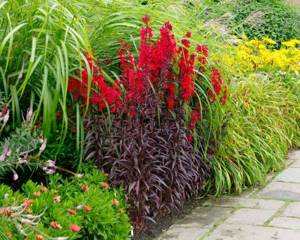
Lobelia Queen Victoria
Lobelia: photos, varieties, application in landscape design
In the photo, lobelia is recognizable by its delicate flowers and lacy foliage. This small-flowered crop is a constant inhabitant of flower beds and mixborders; it is also incredibly good in ampelous compositions on the site. Dwarf varieties with a compact crown in the shape of a pillow or hemisphere are in demand when designing rock gardens, rock gardens and rock gardens.

Ground cover lobelia, a photo of flowers can be seen here, quickly grows a carpet of greenery and dresses in an outfit of garlands of charming inflorescences.
Diseases and pests of lobelia
Pests for lobelia are various insects found in the garden or garden. These include aphids, ants, mites, slugs and beetles. To protect lobelia from their negative effects, it is necessary to use special protective equipment.
Important! We must take slugs especially seriously, as their effects can lead to the death of the flower.
To protect lobelia from slugs, you need to block their paths or use special chemicals. Treatment should be carried out in the evening.
There are several types of lobelia diseases, and they can be bactericidal, fungal or viral. The causative agents are usually various insects. Determining the presence of the disease is quite simple, since unsightly spots of different colors begin to appear on the leaves. Treatment consists of removing damaged parts of the plant, as well as treating it with special medications.

